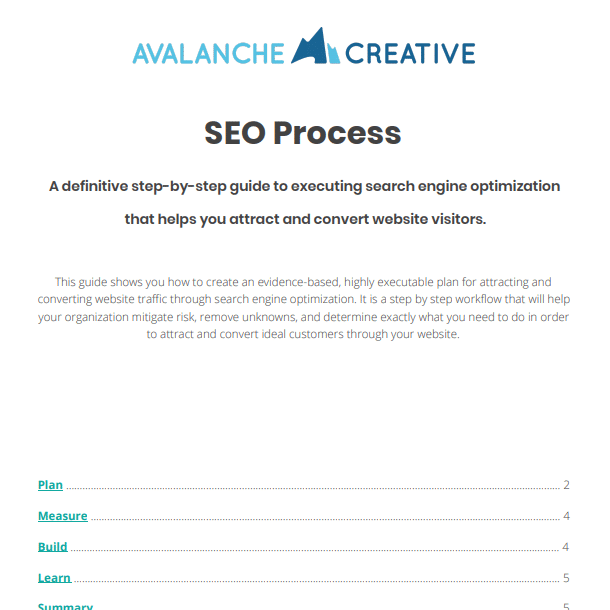The Benefits of Conducting a Content Gap Analysis
Category: Search Engine Optimization | Tags: Content Strategy, SEO, competitive analysis, content marketing, strategy
Conducting a content gap analysis doesn’t exactly sound exciting, but the potential reward for doing so absolutely is! How do you set yourself apart from the seemingly endless amounts of information out there and ensure your content is resonating with your intended audience?
Conducting a content gap analysis is a crucial method to actively engage with your content so that it stays up-to-date and relevant to your audience. It can lead to increased traffic on your website and, ultimately, a better user experience. Think of a content analysis as a way of finding out more of what your audience wants without having to ask!
Anyone who produces content can benefit from a content gap analysis—especially those with a goal to increase traffic to their website and who want to place higher on the search engine results page (SERP). There are benefits across industries, from those in search engine optimization (SEO) and marketing to non-profit organizations and content publishers.
We’re going to dive deeper into:
- What exactly a content gap analysis is and how to identify content gaps
- The benefits of performing an SEO content gap analysis and how it can lead to better engagement
- How to do a content gap analysis for SEO
- Ways to fill content gaps and places to look for help
Table of Contents
What Is a Content Gap Analysis?
A content gap analysis uses data and intentionality to uncover gaps in your content strategy that may be causing you to fall short of the anticipated impact on your audience and, subsequently, missed opportunities. It’s finding topics and keywords that your audience is looking for but that aren’t currently represented in your content.
Knowing how content and keywords perform will allow you to incorporate strategies into where you may be falling short. As trends change and services evolve to meet the changing needs of customers, so should your content strategy. It’s critical to know how to find which keywords are worth targeting in order to drive your business goals. If this is new to you, there are a number of free SEO tools for keyword research, and here are three keyword research tips to get you started.
The frequency of a content gap analysis depends on several factors, including the overall goals of the company, size of the website, amount of content, how quickly an industry’s topic relevance evolves and updates, and more. A cadence of six months to a year is a fairly standard frequency and would be a great place to start. If you find that your content is becoming outdated quickly or the volume of content is becoming repetitive, increase the frequency of audits.
So how do you make sure you’re doing everything you can to keep your content relevant and within reach of your intended audience? By identifying content gaps, you’ll find areas of opportunity to target more of what your audience is looking for, preventing them from having to look at one of those other thousands of sources for it.
Keyword Gaps
Understanding keywords can help identify gaps. There are generally two main types of keywords, and you may unintentionally create a keyword gap by solely focusing on one-word search terms in order to shape your content.
A short, general, high-volume keyword is called a fat head keyword, while the second search, the long-tail keyword, contains more details and specificity. A long-tail keyword often provides insight into exactly why someone may be looking for more information. Perhaps they’ve moved beyond their initial search phase and are now narrowing down the criteria they feel are most important to their overall needs. Targeting them at all stages of their search process is a more comprehensive approach.
For example, you offer junk removal services and see that your competitors are ranking for the keywords “recycle” and “donate” because customers are concerned about how their items will be used or disposed of. As a result, you know to highlight what happens to their items and the efforts being made to be more environmentally responsible.
Learn more about the different types of keywords and how to identify searcher intent in our complete guide for using keywords for SEO. Remember, it won’t matter if your website is full of the right keywords if you haven’t created strong content to back them up.
Topic Gaps
A topic gap helps you find new and innovative content topics for your website. Are there new initiatives or products that you’re launching that do not have corresponding keywords and content on your website? Are there keywords that you’ve identified through keyword research that are not addressed with your current content offerings that could be given more focus and attention on your website?
Perhaps you run a restaurant and recently began to offer a variety of gluten-free options, but they are not on your menu or featured on your website. This would be an example of a topic gap and creates an opportunity to make sure you have accurate and up-to-date information on your webpage.
Content Gap Analysis Example
You’re ready to conduct a content gap analysis and work with your team to identify the overarching goals of your company. The content audit and keyword research is done. You run a city tourism website for the City of Spectre and determine that one of the keywords you weren’t ranking for, but that neighboring major cities are, is “adventure travel.” But you know that your city offers tons of adventure travel! Now what?
You find you have been calling adventure travel in your area by a name that is too specific to your city—The Spectre Experience—and are missing travelers looking to explore your region as a result. By supporting the name with adventure travel content or replacing the specific name altogether with a reference to adventure travel, you will connect with more of your intended audience.
The Benefits of Performing an SEO Content Gap Analysis
Optimized SEO
Once you’ve established a solid SEO strategy, filling content gaps can help improve search engine rankings and visibility, especially for topics you may have overlooked that are ranking well for your competitors. Evaluating both the page ranking in search engine results and how many people are clicking the link to a page helps determine if the ranking keywords are truly reflecting the audience’s objective.
The SEO content gap analysis will optimize SEO by pulling in additional traffic with your new content, but it will also give you an advantage over your competitors.
Additional Traffic
Filling content gaps can lead to additional traffic as it will often reach corners of your audience that you may not have previously connected with up to that point. You will be reaching them at various parts of their journey, not only the one that leads to the eventual selection of a service or product. By doing so, you’ve essentially created your own customer pipeline.
Becoming an expert in your industry will also increase traffic flow. You educated them with valuable content, they trust your resources, and now that they’re looking to purchase, you will be top of their list.
A content gap analysis will enable you to target and create content for previously overlooked keywords. You will also create additional traffic by refreshing your content and maintaining relevance to your audience.
Performing a content gap analysis will also make your content more relevant to those who land on your site, meaning they will stay longer to explore your site and the number of people who land on it who immediately leave, or “bounce,” should reduce.
Better Engagement
Building relationships with your customers is a highly effective strategy to increase return customers and create advocates for your brand. Filling content gaps can lead to better engagement through stronger relationships.
Stronger relationships also mean that they’re more likely to refer your products or services to their network. Referrals tend to make up a significant portion of a company’s customer base.
How to Do a Content Gap Analysis for SEO
1. Perform a Content Audit on Your Website
Before you can identify how to improve your content, you’ll need to take stock of all the content you currently have out there. As you go through your content in detail, keep company goals in mind as they should drive your strategy. Be sure to focus on things like content quality and metrics.
Semrush can serve as a valuable content gap analysis tool. Not only can it help you identify and target keyword opportunities, but it can also help you inventory the content on your website.
The following is a basic outline for conducting a content audit, but steps will vary depending on how much content you have, the size of your website, and the overall goals of your company:
- Take stock of your existing content: Know what’s out there. Be on the lookout for duplicate content or out-dated content.
- Review content for quality and purpose: Is it meeting your expectations?
- Identify opportunities: Look for ways to better align content with your goals and services or products.
- Set a plan: Use data, tools and intention to set a plan of action for addressing shortfalls in content. How will you improve your strategy?
Once you’ve completed your content audit, it’s time to start implementing strategies to fulfill gaps and improve quality in order to attract and retain more of your audience.
2. Research Competitors
How do you stay ahead of the competition? You become extremely familiar with your competitors and what they are doing successfully. This strategy can help you discover what topics your competitors are ranking for that your website isn’t addressing.
If you are unsure where to start, take a look at how to do a competitive analysis for SEO.
3. Consider Your Ideal Customer
Have you ever sat down and put to paper what your ideal customer looks like? If you have, is it time for an update? Taking the time to consider your ideal customer will help you realize what they may already know, or not know, about your industry. This allows you to further identify and target any gaps you may have in content.
Then, you will want to focus on making sure you are creating content with every step of the customer awareness journey in mind. Here are five stages of customer awareness and how they can provide insight into your customer’s buying journey.
4. Review External Links
External links take your visitors to another website and can help boost your domain authority. Placing external links to trustworthy websites will contribute to the credibility of your website in the eyes of Google and your readers. Be mindful so that you aren’t linking to websites that could be your competition and, in turn, competing for the same keyword(s). You will also want to make sure external links open in a new browser tab so the user doesn’t leave your website.
Alternatively, there is a significant advantage to linking to your own site, which also helps reduce your bounce rate because you will keep visitor traffic within your own website and content. Filling gaps in your content will aid in keeping visitor traffic on your website.
5. Expand on FAQs
Educating your audience can attract visitors from other parts of the marketing pipeline and aid in retaining their attention. Having a robust Frequently Asked Questions (FAQs) page is one way to do so, and you should consider incorporating it into your content and SEO strategy. Chances are, if one customer has a question, there are others with the same question, creating another opportunity to satisfy their search for answers.
Consistently collect questions being asked of your producers and services, continuously update your FAQs as new questions arise or as new information becomes available. Connect all the dots by linking to content and resources on your webpage as part of your FAQ answers. Identify which questions and answers can be expanded into articles of their own.
How to Fill Content Gaps
By this point, you should have a good idea of how to identify content gaps and the time has come to fill them. You know where you need to improve your content strategy, so how do you actually tackle it?
Start with a guide. Specifically, a writing style guide. This will help you wrangle your ideas into a usable piece of content. There are a number of external guides you can explore, but there is also benefit to creating one internally to establish grammar and style rules specific to your organization’s content.
Still not sure where to start? Try our step-by-step guide on creating the perfect SEO content template in Google Docs.
After completing the template and associated published content, you will want to track its performance to determine if it solves its mission of filling a content gap. Using tools already mentioned, like Semrush, you can evaluate a piece’s overall impact and success. Another method is to reverse engineer your SEO.
Trust the Content Gap Analysis Experts at Avalanche
Content gap analyses are crucial if you want to improve your overall marketing strategy, attract more quality traffic, convert more sales, and build brand authority. But, as you can see, it takes a lot of work!
Let Avalanche Creative do the heavy lifting for you. We have built a solid evidence-based strategy based on SEO best practices. Our SEO content writing services have a track record of success and include:
- Keyword research
- Search engine results page audits
- Competitive analysis
- Content gap analysis
- Content benchmarking
- User research
- Writing
- Revisions
As we know, a successful content writing strategy truly pays off. Take a look at what we’ve been able to accomplish for our customers!
Want to learn more? Start by exploring our SEO process and consider signing up for our weekly email with SEO and content tips.
Are you ready to take the next step in your marketing journey? Contact us today!
Share this article:
The Avalanche Email: Fun. Simple. Educational. No Selling.
Learn Result-focused SEO & Content
Join over 2,272+ others who get one email every Wednesday with simple instructions on how to get more website traffic and leads through SEO and content marketing. (Learn more about the email)
Keep Learning
🏔️ Earning Preference > Tracking Visibility
Hi friend, Lance here. Today’s email is about a shift we’re seeing and feeling across marketing teams right now: We’re obsessed with tracking visibility but under-invested in earning preference. 🚨 The Problem Every marketer I talk to wants to know how their brand shows up in AI search, LLMs, and assistants. We’re running to new tools that track…
What’s the Best CMS for Landscaping Businesses?
Compare the best website platforms for landscapers. Learn the pros and cons of Wix, Squarespace, and WordPress, and why WordPress is best for long-term SEO.
🏔️ AI & Basketball
AI can generate content, but can it win the game? Learn why outputs ≠ outcomes in digital marketing, and how to use AI like a pro.
Grow Visibility Like You Grow Lawns with Local SEO
Use local SEO to attract more landscaping leads in your service area. Learn how to optimize for locations, maps, and search intent.
20+ Lawn and Landscape Marketing Examples (Updated Weekly)
See how real landscaping and lawn care companies use websites, SEO, ads, branding, and more to attract leads and grow their business.
SEO for SaaS: Effective Strategies for Organic Growth
Boost your SaaS growth with Avalanche’s expert SEO strategies. Drive organic traffic, increase leads, and scale your business.




